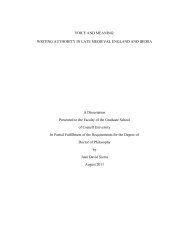Briana Anderson - Cornell University
Briana Anderson - Cornell University
Briana Anderson - Cornell University
Create successful ePaper yourself
Turn your PDF publications into a flip-book with our unique Google optimized e-Paper software.
66<br />
Another limitation of the study is that only one issue (breast cancer research)<br />
was used as a stimulus for the CSR message. This affects the external validity of the<br />
study. People may have different attitudes and expectations depending on the type of<br />
social activity the company is involved in. Additionally, this issue tends to be more<br />
female-oriented. Consequently, these results may only be generalizable to companies<br />
involved in breast-cancer or female-oriented medical research. Future studies would<br />
need to test other types of social responsibility activities to determine whether the<br />
same results hold true to different types of CSR initiatives/activities.<br />
Another issue to consider in this thesis that may affect the generalizability of<br />
its results is the fact that the endorser was a person (Human Resources Manager) from<br />
within the company. People may have pre-existing attitudes about the credibility of<br />
an internal endorser, i.e. they may be more likely to view that person as less credible<br />
because he or she works for the company. Furthermore, an HR manager was chosen<br />
rather than a CEO to represent the endorser. This person may not have as much status<br />
or credibility in endorsement as a CEO. It is also fairly unlikely that an organization<br />
would use an HR manager for endorsement. Future studies could test attitudes toward<br />
using a person other than a CEO (internal) as an endorser. For example, future studies<br />
could test an external ‘expert’, such as a physician (in the case of medical research as a<br />
CSR activity). Testing an external endorser would be beneficial for two reasons. First,<br />
there is more of a choice in choosing a more or less attractive endorser in the real<br />
world (in the case of an internal endorser, the person looks how they look, e.g. the<br />
CEO has a certain look and cannot be substituted with another person). Second, the<br />
results could be compared to the results of this study to see if overall external<br />
endorsers get different ratings of credibility (with attractiveness being the same level).<br />
The visuals themselves present some issues related to the internal validity of<br />
this study. The clothing style and possible perceptions of differences in age could be

















